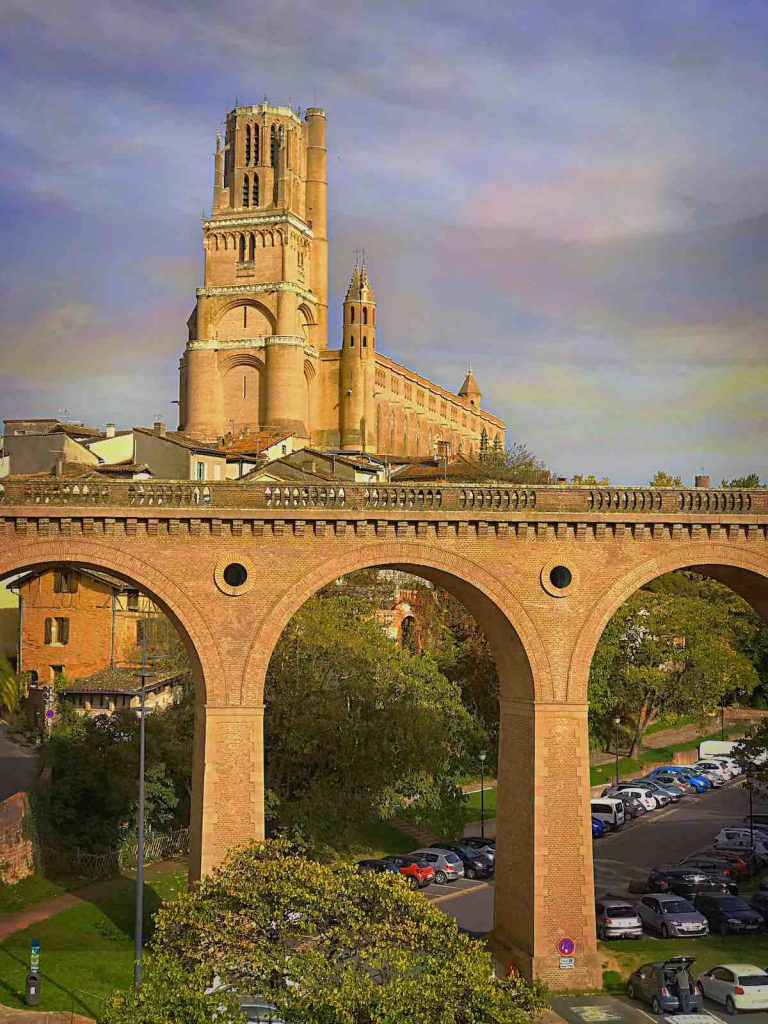We visited Albi during our camper tour through beautiful France. in a search of different French Landmarks we visited Albi. We were taken by the simplicity and beauty of this small French town and spent there two days exploring Albi.
Albi – Introduction
Nicknamed “Red Albi” because of the color of the bricks present on all the facades of the city, the episcopal city of Albi is listed as a World Heritage Site by UNESCO. It is built around the imposing Sainte Cécile cathedral and extends along the Tarn. From Toulouse, it will take you 1 hour by train and 45 minutes by car to reach Albi. Many car parks and camper vans will allow you to visit the historic center on foot. With family or friends, for a simple stroll or an in-depth visit, you will inevitably be seduced by the old bridge with a magnificent view of the city, the city’s museums, but also by the fortifications along the banks of the Tarn, the keep of the Palais de la Berbie and the splendid cathedral which dominates the city.
Discover below all our suggestions for visiting this pretty town in the Tarn in 1 day or for a weekend.
The Old Bridge
150 meters long and built in the 11th century to promote trade and traffic, it is one of the oldest bridges in France. Albi was once an important crossroads between the Mediterranean and the ocean. Crossing point from the Basque Country to Lyon and from Catalonia to Paris, the Pont-Vieux thus housed the toll function where each item was taxed according to a very precise tariff schedule. Today an emblematic monument of the city, you will have from the Pont Neuf located just opposite, a superb panorama of the heights of Albi and the Sainte Cécile cathedral.

The Berges du Tarn
From the Pont Vieux or from the tourist office, the green breakaway allows you to walk 3 trails along the banks of the Tarn. Between 2 and 4 kilometers in length, these walks offer you superb views over the city, over the old fortifications and over restored old brick mills. In summer, sports activities such as trampolines, pedalos, canoes, etc. are offered and you can even have a picnic at the Pratgraussals leisure center where barbecues are available.
Sainte Cécile Cathedral
A true fortress, Sainte Cécile Cathedral is the largest brick cathedral in the world. 114 meters long and 35 meters wide, this cathedral impresses with its dimensions, its bell tower-dungeon reaching 78 meters above the ground. This religious building offers its visitors a collection of exceptional paintings and sculptures with 8500m2 of frescoes and decorations and fully painted walls and vaults over an area of almost 2 hectares. The fresco of the Last Judgment, crowned by a monumental organ is also a true masterpiece. You will therefore not fail to be surprised by the pictorial and sculptural richness of the interior of this cathedral and by its austere exterior appearance.


View of the Sainte Cécile d’Albi cathedral
The Berbie Place
The Palais de la Berbie (meaning bishop in Occitan) is the old episcopal palace of the city which is today one of the oldest castles in France. Built in the 13th century in pink bricks like the Sainte-Cécile cathedral, it forms a harmonious and striking architectural ensemble where you can admire vaulted rooms and medieval pavements, painted ceilings, Renaissance gallery, chapel …
A magnificent garden classified as a remarkable garden is located behind the palace. Characteristic of classic gardens with arabesques of boxwood cut on a bed of white gravel, you will enjoy a panoramic view of the banks of the Tarn, the Pont-Vieux and the old mills of the city.
Gardens of the Palais de la Berbie
The Great Cordeliers Theater
The work of Dominique Perrault, the Grand Théâtre des Cordeliers presents an architectural building wrapped in a gilded copper aluminum mesh, which is tinted according to the sunlight. It can be visited and houses theaters for shows, concerts, congresses and seminars. A restaurant located on the panoramic terrace offers stunning views of the city.
The Grand Théâtre des Cordeliers
Saint Salvi Collegiate Church
The Saint Salvi collegiate church was built on the presumed site of the tomb of Saint Salvi, the city’s 1st bishop. Located at the corner of Place Sainte-Cécile, you will notice the mixture of stones and bricks due to the change of materials between the 11th and 13th centuries, corresponding to the transition from Romanesque to Gothic style. You will discover six large canvases retracing the history of Saint-Salvi and the city as well as a collection of human-sized sculptures.
Toulouse Lautrec Museum
Located inside the Palais de la Berbie, the Toulouse Lautrec museum presents the largest collection in the world of works by the painter. Room after room, you will discover the evolution of this artist through 219 paintings, 563 drawings, 183 lithographs and 31 posters.
Lapérouse museum
Located in the old Albigensian mills, the Lapérouse museum evokes the life and journey of the navigator Jean-François de Galaup de Lapérouse who undertook a scientific expedition off Vanikoro in the Pacific Ocean and disappeared in 1785 during a shipwreck. Navigation instruments, maps, scale models of ships… you will learn all about 18th century navigation.